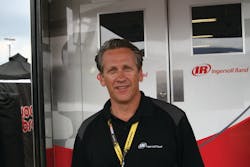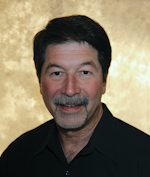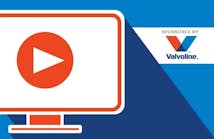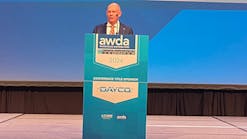Wood Brothers Racing is recognized for turning the racetrack pit stop into a race of its own. But the art of the pit stop was also advanced by another family whose contribution remains just as important and alive today.
In the 1950s, Howard Hurd was an independent tool distributor selling Ingersoll Rand pneumatic tools to mechanics and construction workers in and around Havana, GA. Every year the family journeyed to Daytona for the NASCAR race, and they traveled in the only vehicle Howard owned; the tool van. In those days most of the racers owned only one vehicle too. They drove it to Daytona, deposited the family and luggage on the beach, ran their race and then drove it home Sunday night.
According to Howard's grandson Jimmy, there were several crashes in the 1957 race, and drivers had no tools to repair their cars for the drive home. When they discovered Howard's tool truck among the other spectators on the beach, they bought almost everything he had. Jimmy said it covered the cost of the vacation that year, and Howard made sure he was ready for business the following year.
Bill France Sr., one of the founders of NASCAR, saw all this happen, and when he saw the van in a prominent spot on the beach the following year, he stopped to talk with Howard. Jimmy says Bill France personally invited Howard to bring his tool van to the race track France was to opening the following year, Daytona International Speedway. "In 1959 he brought the van, parked it in the garage, and we've been here ever since."
The right tools
Of course, being in the right place at the right time is only part of the story. In a 500-mile race, the pit crew's tools and techniques play a crucial role. In 1959, they changed tires with a four-armed lug wrench; weighted and polished so the mechanic could spin lug nuts as fast as humanly possible. In 1962, Wood Brothers Racing began using a pneumatic impact wrench they bought from Howad Hurd. "I still have some of the original invoices," says Jimmy. "They asked my grandfather to tweak these things up a little bit…That's when they started kickin' a** down on pit road." Jimmy says the Wood's car could enter the pits a lap down and leave pit road in first place. When other teams learned about their 'tweaked' impact guns, Jimmy says "everybody started buying 'em. They're the original air guns, and we're one of the first distributors in the southeast."
That tool is the Ingersoll Rand Thundergun, and it's the only impact wrench used in NASCAR pit stops. According to Jimmy, there's no rule or special business deal involved: they all use the Thundergun because it's the fastest tool that NASCAR tire changers have found. Jimmy Hurd (now in his 28th season) took over the business from his grandfather, so the Hurd family has been the only source of race-prepared Thunderguns from the beginning.
The technology
Jimmy says the success lies in the air motor's speed. "We use a high-tech air motor that revs pretty fast (up to 18,000 rpm). Nut-to-nut it has to make a quick (speed) recovery because it's the rpm making it all happen." Though modified for race duty, Jimmy says it has all the same parts of the stock impact gun. "The weight (of the spinning anvil) is what actually breaks the nut loose and the rpm takes it off. Going on, the rpm dictates the torque. They're not driving it on all the way. That lug nut is spinning so fast, that's what makes it tight."
A quick look at the socket makes this easier to understand. It's a six-point socket, but unlike those in your toolbox, the flats between them are hollowed out, leaving literally just six rounded-off nubs. It only takes a little bit of torque to make the socket slip on the nut, so the socket basically just shoves the nut around.
Nitrogen is used to power these tools because it's dry, typically regulated to 110 psi. The gun has an oil reservoir packed with cotton, like a Zippo lighter, and Jimmy says the crews fill them up before each pit stop even though total run time is only about 4 seconds. Jimmy customizes the location, shape and size of the gun's exhaust port as requested by the customer. "Front tire changers want the port on the side because brake dust would blow in their face with a standard front exhaust. The new one has bigger port for more rpm." He says there's always a compromise between rpm and torque, "but in this situation you need both. So with this gun, torque will be the same off and on…it's just a little slower going on so you don't get the nuts too tight. If they're too tight, it can take more than 190 ft-lbs to remove the nuts. That might only take half a second (more), but that could be enough to lose 15 spots on pit road…The better teams hit 5 lug nuts in 8 tenths of a second and put 70-130 ft-lbs on each lug nut."
Jimmy also modifies the reverse switch. Each tire changer wants just the right stiffness on that button, and Jimmy can 'tune' the effort required to push it. "Whatever you want, I can to it. Sometimes the valve will wear down and I have to replace it, and there are different buttons too." But switch stiffness is determined mostly by size and composition of an O-ring, and by ambient temperature. That's why tire changers keep their impact gun in an insulated holster-shaped bag. "Sometimes guys will put a baggie of ice in there, and in wintertime they'll use heat packs."
Future business
During the racing season, Jimmy is at the track every weekend. He's the only source of racing impact guns and service for all the NASCAR tire changers. Most tire changers keep one gun just for race-day, but they practice 3 to 5 times a week using another Thundergun with the same set-up. Jimmy maintains those guns too. He used to supply other racing series too, including Indy Car, but he says "this is getting so busy…this is pretty much all I do anymore."
Even so, Jimmy Hurd is planning to expand the family business. Recently he's had calls from F1teams in Europe. He calls that a "golden opportunity" because the racing industry in Europe is much bigger than in the 'States. "In about 2 years you'll see a trailer like this over there doing what we're doing here. That's my plan." So after 50-some years in business, H. M. Hurd Pit Tools and Equipment will finally expand beyond a one-man operation. It's too early to know what tools will be used, but it looks like the Thundergun will definitely be around for a long time to come.



